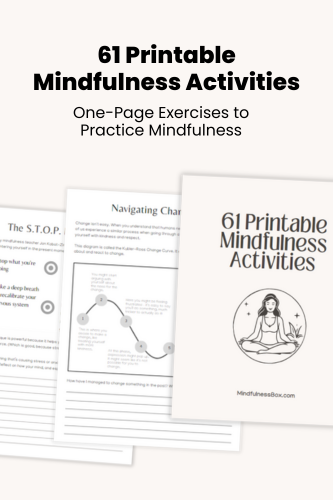Scripting manifestation takes the principles of manifestation and encourages you to take action using pen and paper. It’s essentially a form of manifestation journaling. Often, scripting manifestation prompts can aid the process.
If you’re hoping for a new job, for example, or hoping to find love, you’d write in your journal as if you were writing from a future in which you’d already gotten what you wanted.
By including lots of details and dreaming big, you’re able to expand your sense of possibility and start to truly believe in a future in which what you want is not only possible, but inevitable.
Get dozens of one-page exercises to help practice mindfulness, meditation, gratitude, and self love. Perfect for printable handouts when teaching mindfulness to groups, students, or in the workplace.
To see examples, plus a full list of the 61 exercises included, click below.
This sense of belief and conviction motivates you to take action, which helps bring your vision into reality.
What is scripting manifestation?

Scripting manifestation is pretty simple. Essentially, it’s journaling or writing about your vision as if you had already reached it.
Just as with visual manifestation, your job is to imagine, in vivid detail, what it looks and feels like to be in the future moment where your vision is now reality.
The more details, the better. Allow your imagination to run wild.
Then, put pen to paper.
Imagine yourself in your future reality and write about where you are, who you’re with, what emotions you’re experiencing, and how you feel. Cover the five senses: touch, taste, smell, sight, sound. Allow yourself to imbue the moment with so much detail that it feels real.
As you write, you might encounter limiting beliefs.
Write about those, too. You can explore them as a part of your scripting manifestation. Consider why you hold them and what you might be able to do to release them.
Finish with gratitude, to help you come from a place of abundance rather than lack.
You can return to the same vision again, scripting multiple times to remind yourself of the detail of your vision and enhance your commitment to the outcome. Some people have scripting manifestation journals specifically for this purpose.
Benefits of scripting for manifestation
Manifestation often relies on visual cues like vision boards. And vision boards are excellent tools that can complement scripting manifestation.
But not everyone’s style is visual.
Here are some benefits of writing instead:
- Internalizing your vision: For some people, the act of writing things down by hand helps them to internalize the vision they’re creating.
- Easy to see progress over time: Another benefit of scripting manifestation is that it’s easy to revisit, add to, and track your progress. Writing leaves a more detailed trail than vision boards do. If you keep a manifestation journal, it’s not hard to flip to the beginning and see how your entries have changed from the start until now. You’re likely able to see progression over time, which can be highly motivating and increase your commitment to your vision further.
- Simple to create built-in reminders of your vision: Scripting manifestation also makes it easy to create reminders so you’re never far from the vision you want to hold in mind. Whether you print it out or schedule it to be sent to you automatically each week via a service like sendrecurring.com, the written word is adaptable and gives you many opportunities to keep your vision top of mind.
How to write a manifestation journal

Ready to get started with scripting manifestation?
Here’s a step-by-step guide to writing in a manifestation journal using scripting:
- Start by expressing gratitude: Before you start with your vision, get yourself on the frequency of gratitude by writing down appreciating something in your life. This, in addition to all the other reasons to be grateful, puts you in a mindset of abundance rather than lack.
- Allow yourself to dream: Ever feel like your dreams are limited? Many of us don’t let ourselves dream as big as we should. Start there. Pretend there are no obstacles or constraints in your life. What would your life look like? Now, put yourself in that future moment. What does your life look like (present tense). Use exceptional amounts of detail here.
- Write down your vision: In the last step, you exercised your imagination. In this step, write all that down. Make sure to write from the future, but use the present tense. Add more detail than you think you need to. What do you see? How do you feel? Who are you with? Where are you?
- Address any limiting beliefs: As you write down your vision, parts of you might not really believe it. It’s okay. You’re dreaming bigger dreams than normal. Use this opportunity to write down the objections coming up in your mind. Ask yourself why they might be coming up, and how you may be able to let them go.
- Return to your vision in future writings: Your vision won’t happen on its own. After writing it down, believing it, and addressing limiting beliefs, you’ll still need to take action. But the manifestation method is so powerful because it strengthens your conviction and focuses your attention. Return to your vision in future manifestation journaling sessions to continue to conviction and attention towards your goal.
5 scripting manifestation examples for your manifestation journal

Remember, these manifestation journal prompts are in the present tense—but are actually happening in the future, AFTER you’ve already achieved your vision.
What you’ll want to touch on in each manifestation is:
- Gratitude
- Describing your vision in detail
- More gratitude
Your full journaling entries will most certainly go into more detail, but these examples should give you an idea of how to move forward.
1. Scripting manifestation for moving abroad
“I’m so lucky to live where I live, and have the support network I have. A year ago, I never would have thought I could be living in another country, learning a new language, and making new friends. Sometimes I still can’t believe it: I live on an island in the Caribbean. My apartment has a view of the ocean, and I can see the sunrise each morning. My life is richer than I ever imagined. I want to tell the “me” of a year ago to be brave and take a leap of faith, because the rewards are greater than you’ll ever know. I’m grateful for the changes I’ve made in the past few years that have allowed me to reach this point.”
2. Scripting manifestation for love
“Who could have imagined that in just a year, I could go from being single and frustrated with life to finding the love of my life and moving in together? It’s beyond my wildest dreams and I’m so grateful life has taken me to this place. I took a chance and put myself out there in order to meet her, and I’m so glad I did. When we first met, we clicked immediately, and by the second date, I knew we were meant for each other. She’s funny, smart, attractive, thoughtful, outgoing, and adventurous. Meeting her is the best thing that’s ever happened to me and I’m so thankful that it happened.”
3. Scripting manifestation for a new job
“For years, I worked a job I didn’t like much because I thought I had no other option. But I’m grateful for that experience, and all of my past jobs, because they helped me understand myself, what I want, and what I don’t want. Where I am today wouldn’t be possible without where I’ve been. After just a few months of soul-searching and exploring, I’ve finally found a career that feels right for me. I’m using my skills and passions in a way that feels natural and exciting, while also allowing me to make a good living. Each day, I wake up excited to get on with the work of the day. Sunday nights are no longer spent dreading Monday! I never thought I’d find a career that I wouldn’t mind keeping for the rest of my life, but now I have. Instead of dreaming of retirement, I’m now dreaming of new projects I can build in my professional life. I’m thankful for the direction my life has taken and all the experiences that have led me to today.”
4. Scripting manifestation for money

“I’m grateful for everything that I have, and I know that it’s already enough. For years, I’ve made it a goal to reach a stage where I don’t have to think about money. Where, rather than coming from a place of scarcity and lack, I’m able to live life without worrying about money coming in. Where I’m able to make decisions in my life driven by what I want to spend time on, rather than what makes money. I’m so thankful that over the past two years, I’ve reached that point. It happened much sooner than I thought. When I look at my bank account, I feel gratitude and abundance. When I think about how to spend my days, I feel joy and excitement and appreciation. It feels like money is now no longer an obstacle, but a tool to live more fully, now that I don’t have to focus on it.”
5. Scripting manifestation for happiness
“I’m thankful for who I am and all of the personality traits that make me “me.” Searching for happiness has been a lifelong pursuit for me. For some, happiness comes easier than others, and for me, it hasn’t always seemed to come easy. That’s why I’m so grateful to realize that looking back, the past few years have been a time of increasing happiness in my life. I now look less and less to external events and circumstances to make me happy. Instead, I focus on cultivating inner peace and living each day with joy and a sense of adventure and playfulness. It hasn’t happened right away, but zooming out, I can see a huge difference between how happy I am now and how happy I was a few years ago. I want to reach out and tell that version of myself to have patience, that it takes time, but that the rewards are immense. Whereas I used to wake up each morning with a sense of frustration, I now wake up with a sense of possibility. For the first time in a long time, I feel like I can call myself a “happy person.” I’m grateful for having had the chance to cultivate the skills needed to reach this point.”
Getting started with manifestation journaling
Now that you know how to move forward with scripting manifestation and have a few examples, the next steps are easy.
Grab a journal or find a piece of paper—some people connect best via the physical act of writing by hand, although there’s nothing magical about it.
You can also open a new document on your computer.
Dream big, start visualizing what you want your life to look like in detail, and shift your perspective towards a future in which it’s already happened.
Then, start writing and create a vision you fully believe in.
It may turn into reality sooner than you think.
Frequently asked questions
What are some manifestation journal examples?
Manifestation journaling can be a private and intimate practice, but when you’re not sure what to write, it’s nice to have some examples.
If you were wanting to manifest a new job, for example, you might write something like:
“For years, I worked a job I didn’t like much because I thought I had no other option. But I’m grateful for that experience, because it helped me understand myself – what I want AND what I don’t want. Now, I’ve finally found a career that feels right for me. I’m using my skills and passions in a way that feels natural and exciting, while also allowing me to make a good living. Each day, I wake up excited to get on with the work of the day. Sunday nights are no longer spent dreading Monday! I never thought I’d find a career that I wouldn’t mind keeping for the rest of my life. I’m thankful for the direction my life has taken and all the experiences that have led me to today.”

My mindfulness practice kicked off in 2016 with a ten-day silent retreat. Since then, I’ve read dozens of books about mindfulness and completed hundreds of hours of meditation. Thinking about what makes humans happy, calm, and peaceful is endlessly fascinating to me.


